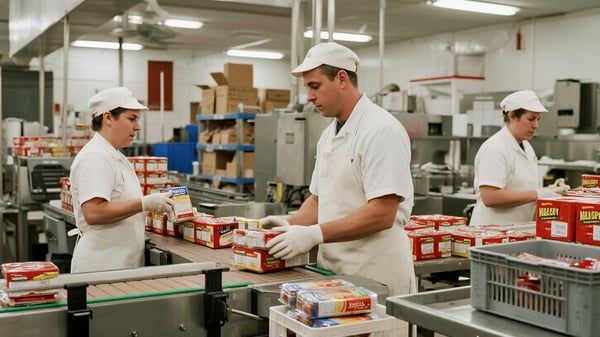Understanding Food Packaging Jobs in the U.S.: Duties, Skills, and Outlook

Main Duties of Food Packaging Workers
Food packaging workers are responsible for preparing and packaging food items for distribution or retail. Their daily tasks typically include:
Operating machinery to fill, wrap, seal, or label products.
Inspecting products for quality assurance and safety compliance.
Cleaning and maintaining packaging equipment and workspaces.
Monitoring supply levels and reporting shortages.
Following strict hygiene and food safety regulations.
Depending on the facility, workers may package items manually or use automated equipment. In larger plants, assembly-line systems are common, requiring quick hands and high attention to detail.
Skills and Qualifications Needed
Entry-level food packaging jobs generally do not require advanced education, making them accessible to many. However, employers often look for candidates with:
Physical stamina and the ability to stand for long hours.
Basic math and reading skills.
Good hand-eye coordination.
The ability to work in cold or hot environments.
An understanding of hygiene and food safety standards (such as HACCP or FDA regulations).
In some cases, training in forklift operation, food handling certification, or experience in warehouse or production environments can be advantageous.
Typical Work Environments
Food packaging jobs are often found in:
Food manufacturing plants.
Frozen food facilities.
Bakeries and snack factories.
Meat processing plants.
Dairy or beverage companies.
The work environment may involve exposure to refrigerated areas, repetitive movements, and sometimes fast-paced production targets.
Wages and Benefits
Wages for food packaging workers vary by state, experience level, and company size. As of 2024:
The average hourly wage ranges from $14 to $20.
Entry-level positions may start around $13/hour, while more experienced or supervisory roles can exceed $22/hour.
Many companies offer health insurance, paid time off, and shift differentials for night or weekend work.
Unionized facilities may also provide higher wages and more job security.
Career Advancement Opportunities
Although many food packaging roles are entry-level, there are paths for advancement, such as:
Line supervisor or shift leader positions.
Quality assurance roles.
Machine maintenance and technician positions.
Food safety compliance staff.
Training programs and certifications in industrial equipment or quality control can help workers move into higher-paying, more specialized roles.
Industry Outlook
The U.S. food packaging industry remains stable and essential. Factors influencing growth include:
Rising demand for ready-to-eat and packaged meals.
Increased focus on eco-friendly and sustainable packaging.
Ongoing labor demand due to high turnover rates.
According to the U.S. Bureau of Labor Statistics, packaging and filling machine operators are expected to see steady employment, especially in regions with strong food manufacturing sectors such as California, Illinois, Texas, and Georgia.
Conclusion
Food packaging jobs offer a reliable entry point into the manufacturing and logistics workforce. While the work can be physically demanding, it provides steady employment, opportunities for advancement, and access to key benefits. For those seeking stable, hands-on roles in the food industry, food packaging remains a practical and in-demand option.